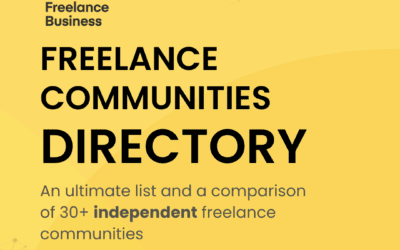The way many companies handle their hiring strategies today is a bit old-fashioned and does not include contingent workers, such us freelancers. One of the reasons that companies are not always keen to work with independent workers is because there is a myth that freelancers are way more expensive than employees. Today we will show you how you can address this as a freelancer when you hear clients say you are too expensive.
When a company wants to find resources, it usually starts with the line manager, who is responsible that all the departmental activities are handled with the workforce available within the company. Within most of the companies, if there is a lack of resources, the line manager should turn to the HR department to try to find some new internal expertise. For example, it can be fixed employees on the payroll, it can be a temporary worker for a temporary position, or it can also be job students.
On the other hand, in some companies the skills gap can be filled in by external expertise. There are different types of external expertise – freelancers, project sourcing (people that are on the payroll of company A, but that are lent to a company B), etc. You can also work with subcontracting companies and you can also outsource your company activities.
In the old way of working we had a separation between HR (hiring as an employee) and procurement (hiring external i.e freelance). And in the case of employees – they are classified as labour costs and that’s in the budget of the human resources department. If we’re looking at the costs for freelancers for example, those costs are classified as operating costs per department and managed by procurement (or line department) and do not fall under human resources budget anymore.
Employees vs freelancers – the total cost of ownership
If a company compares the cost of an employee or freelancer by taking an invoice of a freelancer and the payslip of the employee, they will see a huge difference in the amounts both get and they think that to hire a freelancer is more expensive than to have someone on a payroll.
What companies need to look at is the TCO (the total cost of ownership) of employees and freelancers, and when they do the comparison between those two contract types, they notice that the difference in the total cost for a company is not that big.
If we take a look at the pay of a freelancer: we have their per hour, per day or per project fee defined by the contract from which the freelancer is responsible for their own taxes, social contributions and other obligatory payments. Employees, on the other hand, receive a payslip with the salary. All the other costs associated with the employee salary payment – tax, social contribution, etc are taken care of by the company.
An employee may also receive compensation and benefits like a car, laptop, gift vouchers, telephone, and also (that’s specifically in Belgium) have a 13 month salary per law, plus vacation money. So if we are taking into account the total cost of an employee, you actually have to multiply the salary x 13.92. That’s not always taken into account by companies when paying a freelancer. When employees take vacation or they’re ill for one day or they’re ill for two months, they’re still being paid. Plus, companies do not count all the training or educational sessions, events for the employees and the costs associated with that. The figure on the payslip is really not representable for the total cost of an employee for a company.
So whenever a corporate hiring person tells you that a freelancer is expensive, show them this table:
| Cost of a freelancer | Cost of an employee |
| Project fee | Salary + taxes and social contribution |
| Vacation pay and sick leave pay | |
| Pension funds contribution | |
| Car, fuel card, car insurance | |
| Telephone and phone subscription | |
| Utilities: electricity, heating, water in the office | |
| Internet and tech maintenance | |
| Lunches and tea/coffee | |
| Healthcare insurance | |
| Attendance to trainings and events | |
| Other benefits or bonuses that are offered to an employee (warrants, shares, etc) |
Studies also show that in comparison with an employee, freelancers have added value from day one. Why? Because they are used to changing environments and working for different customers and different projects – they know how to get started within a company from day one. Employees don’t tend to have that experience. Studies show that freelancers are more efficient and often help companies to optimise their processes. Therefore this should also be considered as a return on investment for a company when engaging a freelancer.
So what is Total Talent Acquisition and why is it not for everyone yet?
When we look at the table above, we may realise that hiring freelancers is actually cheaper and more convenient for companies. It therefore leads the markets to engage with new sourcing strategies, such as the total talent acquisition. Another term for it is total talent management.
The definition of total talent acquisition is the definition of Charipickers, because total talent acquisition is something that has a lot of other ways to be used in the industry. Total talent acquisition or total talent management is a holistic way to look at the current talent in your own company at the moment, but also a holistic way to look at the working human capital. It’s looking more at the talent that is within your company, how you can train them and educate them to fill talent gaps within your company, but also how we can leave the perception that one job has to be done by one person within a company.
The first step that companies need to take to adopt a new sourcing strategy is to redefine the role of HR and procurement in talent acquisition. HR, which is traditionally dealing with (internal) human resources, considers freelancers as vendors. They know how to hire people as employees, they have the framework for it, but they don’t have this framework for hiring freelancers, because in their perspective they are vendors. Vendors traditionally are handled by procurement. And procurement has the framework and processes for how to manage a supplier. Therefore in HRs perspective – it is the role of the procurement, to deal with suppliers such as freelancers (external). Procurement at the same time has no idea how to treat ”vendors” who are actually human beings.
To move this from the dead end, HR should learn to be involved in dealing not only with internal, but with the external experts as well. Procurement can still be the department in charge of the contracts and negotiations and the prices, but actually the recruitment process should be reallocated to HR. It’s the HR that has to define in which cases it’s possible to go for internal expertise or when to go for external expertise like freelancers.
Here is what Charipickers recommend to start with:
Step one. The first step companies need to take is to let go of the belief that one person has one fixed job description. In a company, you have a lot of activities that need to be done. And companies should really detect those activities and map them and really define which talents or capacities are needed to have those activities done.
Step two. When you have mapped activities, you have to match them with the current talent. They have to see which talent is capable or has the skills to perform those activities.
Step three. Based on the first two steps, the company will notice that they have talent gaps. And talent gaps are key in a total talent acquisition strategy. When you have determined activities that need to be done in a company, and you have determined whether these activities can be performed or not by your current talent pool, you will discover the talent gaps. And those talent gaps nowadays, in the old fashioned way are mostly filled with internal expertise. In the total talent acquisition strategy, we turn that around – if we know which talent gaps we have in a company, we are going to define the legal basis in which we can engage with external experts. And in this case the contract type (HR or Procurement) is not the leading factor anymore. Removing this barrier is the most important step in successful total talent acquisition.
Step four: The contract type – be it a fixed employee, a temporary worker, a job student or a freelancer subcontracting outsourcing, it doesn’t matter anymore. A company should look for the best talent available on the market regardless of how this talent can be hired. What matters the most is the relevant skill set and the culture fit with the company.
Learn more about freelance contracts in our article.
Step five: Repeat. Every time they need to assess the activities in their company – which current talents, internal or external, are capable of doing that, what are the talent gaps in the company, and which talents are out there in the market to fill them. They should not let the contract type be leading, but the quality of talent on the markets and the cultural fit. And that’s a huge opportunity in the future for freelancers – if companies start looking for the best talents and not make the separation between internal and external talent and not be fixed on contract types, we will see more opportunities for freelancers to be part of their talent sourcing strategy.
That’s actually how talent acquisition works and how companies should use it in the future, and that’s a big opportunity for freelancers that talent will be leading in the future and not the contract type.
Is it for every company?
We think the answer is yes. We believe every company can use this sourcing strategy and it’s important to say that a lot of companies are already using the strategy, but they don’t know it. Currently when they’re trying to find an internal resource and they face difficulties, then they engage with a freelancer on a temporary basis and to have more time to find an internal employee, so it is already in place that companies use external expertise, but it’s really just the first step. We also see that companies already use types of contracting like subcontracting and outsourcing, but in a rather ad-hoc way – not as a part of their total talent acquisition strategy.
We also see that the big corporations at the moment have the most difficulties in implementing this strategy. It’s actually the scale-ups that are more successful in incorporating internal and external staff in their strategies. They can really scale their activities on the market because they are flexible and move fast. Big corporations are like whales – it’s really difficult for them to incorporate this strategy and that’s why they can go out of business quickly – because they’re not changing quickly enough.
Another trait of an old and old-fashioned way of working is when there is a need or a vacancy for a freelancer, companies tend to go to recruitment companies and as we all know recruitment companies take a margin on the rates of freelancers, adding to the costs of the talent acquisition for the company.
What progressive companies are actually doing at the moment is they’re creating their own talent pools. So that every freelancer they’ve worked with in the past is registered in a database and they reconnect with them on a regular basis to see if they’re available for a new project. There are also new tools on the market that companies are using to expand their pool of freelancers. One of the tips today for freelancers is to really look at the talent pools that companies are using to cut out the middle man. Companies are changing their strategy from using recruitment agencies to using talent pools. It takes some work in the beginning because you have to register with each company you’re interested to work with now and in the future, but you’re sure that you’re working directly with the end customer.
In conclusion
Companies will struggle to find the right talent if they keep working in the old-fashioned way. But if they start to realise that freelancers are not more expensive than employees, and that they need to look at the total ”package” of what it takes to involve a freelancer, start detecting the talent gaps that can be closed much faster and more efficiently with the use of freelancers, they will realise that access to the talent and cultural fit will be of leading importance, and they will work on creating a proper contractual framework both on HR or Procurement side to facilitate the the faster talent acquisition.
For further information on hiring freelancers for your business see Ian’s expert guide here.

Ian de Swart is the co-founder of Charipickers (Belgium based) and has worked in the HR sector for more than 10 years. Charipickers is an HR partner for companies and helps them to integrate strategies to attract, retain and manage the talent.




